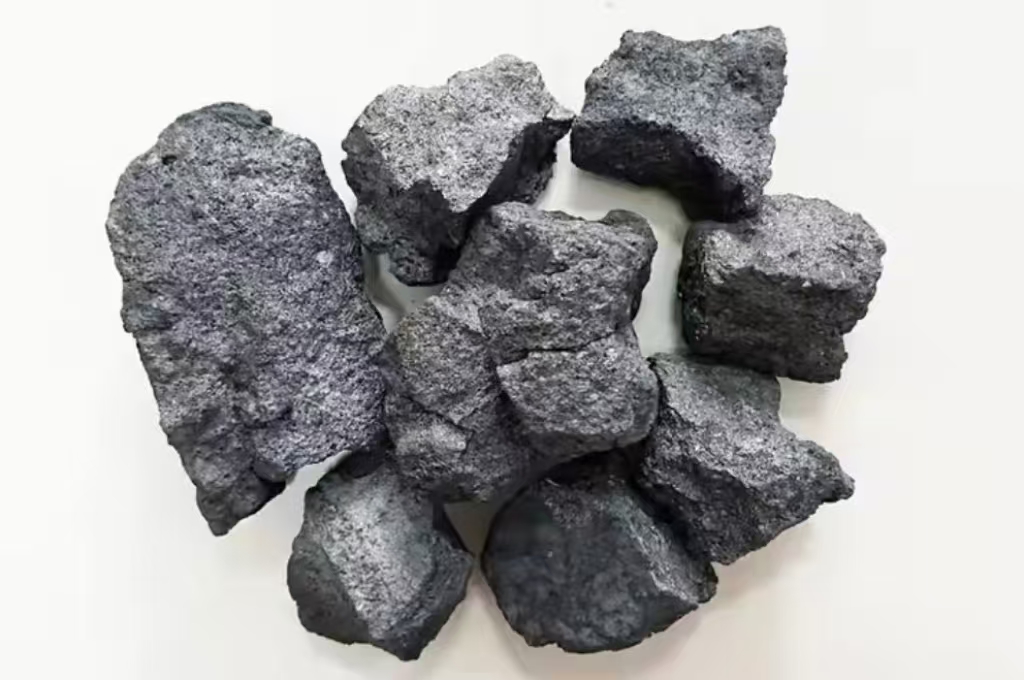冶金プロセス、特に鉄鋼の生産は、特にコークスに依存している。コークスの特徴は、炭素含有量が高く、強度があり、不純物が少ないため、高炉で使用できることです。冶金プロセスにおいて、コークスの主な役割は、熱源と炭素源の還元剤を提供することである。鉄鉱石中の酸化鉄を純鉄に還元するのに必要な炭素を供給し、同時に製錬に必要な熱を発生させる。
目次
トグル冶金コークスとは?
冶金コークス (メットコークス)とは、石炭を炭化した固形燃料の一種で、主に高炉製鉄や非鉄金属の鋳造・製錬に使用される。 酸素のない炉(コークス炉)で石炭を高温で加熱して製造される(コークス化というプロセス)。 このプロセスにより、水や硫黄、ガスなどの揮発性化合物が除去され、非常に高い含有率を持つ固体の多孔質材料が生成される。 カーボン.
冶金用途におけるコークスの主な用途は、鉄鉱石を溶けた鉄に変える高炉で、高温で一酸化炭素(CO)還元剤を製造するための燃料である。メットコークスは、費用対効果の高い製鉄を可能にするためにカスタマイズされた重要な特性を持っている。
石炭コークス対メットコークス
コークスはすべて同じではない。石炭コークスと冶金コークスはどちらも石炭から作られるが、その目的は異なる。一方、石炭コークスは一般的に非冶金製品として、工業プロセスの燃料や化学薬品の製造に使用される。一方、冶金用コークスは、鉄鋼やその他の金属を製造するために調製・製造される。
そこで、石炭コークスとメットコークスの違いを説明します。メットコークスは、高炉の高温と化学プロセスに耐えるために、より高い抵抗性、純度、気孔率で製造されます。また、硫黄や灰のような有害な不純物が金属製造工程に混入しないよう、きれいに燃焼させる必要があります。
高炉におけるコークスの機能
燃料源:
コークス- 燃料源(鉄鉱石を溶かすのに使用される)。高温(約1,000~1,200℃)で燃焼し、炉に必要な熱を集中させる。コークスの高い発熱量がなければ、炉は鉄鉱石の製錬に必要な温度に達することができない。
還元剤:
製錬では、コークスが鉄鉱石(酸化鉄)中の酸素と反応して一酸化炭素を生成し、この一酸化炭素が酸化鉄を(鉄)に還元する。 この化学プロセスは、鉄鉱石を溶けた鉄に変えるために必要である。 コークスに含まれる炭素は、鉱石から鉄を還元するのに必要な化学結合の形成にも役立つ。
最後に、コークスはガスと溶けた鉄が自由に流れるように炉を構造的に支える役割を果たす。
冶金用コークスの特性
高い強度:コークスは炉の高圧に耐えなければならない。強度の高いコークスは、製錬過程で何トンもの金属鉱石が積み重なっても、その圧力で粉々になることはない。
多孔性:
滑らかな構造(高い気孔率)を持つコークスは、ガスがコークスを自由に通過し、鉄鉱石との反応を促進する。また、溶鉄の製造に必要なガス交換も容易になる。
不純物が少ないこと:コークス中に含まれる硫黄、リン、灰分などの不純物。最終製品を汚染し、最終的に鋼の品質に影響することが多い。良質のコークスは、不純物が少なく、ほぼ純粋な炭素でなければならない。
熱安定性:コークスが高熱下で分解や化学反応を起こさず、安定した状態を保つ能力。そのため、ゆっくりと燃焼し、炉内で一定の熱を与える。
冶金用コークスの組成
冶金用コークスは、高炉で鉄を生産する際に利用される最も重要な材料である。 主成分は炭素(85-90%)で、硫黄、灰分、水分は少量である。 これらの要素の正確な比率は 使用する石炭の種類とコークス化工程による。
炭素:コークスが燃料としても還元剤としても機能するのは、炭素含有量が高いからである。 鉄鉱石と反応し、鉄鉱石の還元に必要な一酸化炭素を形成する。
硫黄:製鉄の敵、 サルファ は鉄鋼生産を低品質にする。つまり、高品質の製品を得るためには、冶金用コークスに含まれる硫黄分を可能な限り減らす必要がある。
灰分:灰分も低くする必要があり、これが過剰になると炉スラグが生成され、鋼材の欠陥につながる可能性がある。
水分:水分が多すぎると効果的な燃焼が妨げられ、望ましくない化学反応を引き起こす可能性があるため、水分含有量も管理する必要がある。
コークスと鉄鋼生産
コークスは、鉄鉱石を溶けた鉄に還元して鉄を作るために高炉に入る、この鉄を作るための核となる材料である。高炉では、コークスが燃えて反応し、鉄鉱石と結合して溶けた鉄を作る人工的な環境が作られます。この化学反応によって二酸化炭素と一酸化炭素が発生し、これが鉄鉱石を還元して鉄を生産するのに使われます。コークスは 一酸化炭素鉄鉱石から酸素を除去し、純粋な溶鉄を得る。
生産された溶鉄は、さらに精錬して鋼鉄を生産することができ、鋼鉄の最終的な特性は炭素含有量によって決定される。最終製品は、炉内のコークスの品質と清浄度に直接影響される。
冶金コークス価格
また、原料炭価格、世界の鉄鋼需要、輸送制約から冶金コークス価格を導き出す。コークスは鉄鋼生産における主要な投入資源であるため、コークス価格は変動する鉄鋼価格に密接に連動する。コークスは鉄鋼製造に必要なものであるため、鉄鋼需要が増加するとコークス需要も増加し、価格が上昇する傾向にある。
輸送コスト、石炭の入手可能性、環境規制など、その他のコストもコークス価格に影響を与える。鉄鋼を生産する企業にとって、コークス価格を把握することは不可欠である。価格の変動は生産コストに大きな影響を与えるからだ。
冶金におけるコークスの役割:単なる燃料ではない
コークスは熱を発生させ、還元剤として機能するという主要な機能を持つが、その品質は最終製品の品質にも影響する。鋼の特性は、消費されるコークスの量、化学組成、関連する化学反応にも影響される。
例えば、コークスの炭素含有量は鋼の炭素含有量に影響し、鋼の硬度、強度、延性に影響する。また、コークスは炉内の温度を安定させ、鋼の生産条件を向上させる。
コークスは単なる燃料ではなく、最終的な鉄鋼製品の品質を左右する重要な要素なのだ。
結論
コークスは、鉄鉱石を溶けた鉄に変えるための熱と炭素を供給する。コークスがなければ、高炉は正常に機能せず、鉄鋼の製造工程は大幅に効率低下する。鉄鋼生産においてコークスの使用量は最終製品の品質に影響するため、コークスの品質とコストは注意深く監視されなければならない。

